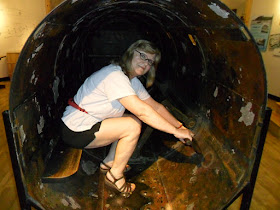Yep. A submarine. That's what I'm sitting inside of in that photo. (Way to go, Ian!) Not the FIRST submarine, mind you, which was built way back in 1620 by a Dutch engineer named Cornelius Jacobszoon Dribbel, but it IS an accurately-sized cross section of a mock-up of the first submarine that successfully sunk a ship. And that occurred during the Civil War.
Kind of a tight squeeze, huh? That crank in my hand? Believe it or not, that's how the crew members propelled the sub.
Have you ever been inside of a submarine? A modern one, I mean. The quarters are tight enough to drive a claustrophobic person insane. The very idea of being sealed up in a vessel while UNDER the water has always given me the creeps. (I can't hold my breath very long, for one thing...) Even so, the history of submarines is a fascinating topic. If you have any interest in the role of subs during the Cold War, I highly recommend the book Blind Man's Bluff by Sherry Sontag and Christopher Drew. It contains a lot of declassified information about submarine espionage, and some of the stories about things submariners endured while UNDER the water more than justifies my trepidation.
Okay! Back on topic... back to the Civil War submarine. The size of that tiny vessel takes tight squeeze to a whole new level. It's forty feet long, and as illustrated in this pic, only four feet tall and 42" wide. And in that small area were eight hunched-over hand-cranking crew members! Wait... that's not entirely true. Only seven were actually cranking. The commander, Lt. George Dickens, who was over six feet tall, was situated in the front of the sub... the eyes of the mission, so to speak.
A picture showing a size comparison. The Housatonic, part of the embargo preventing goods from getting into Charleston, was selected as a target primarily because its hull was constructed of wood. In spite of the odds against the little sub, the mission was a success, and the much larger ship sunk in approximately five minutes.
But the Hunley... never returned to shore.
Its location remained a mystery until 1995, when a team of divers found it. Five years later, it was oh-so carefully raised from its watery grave, and it's been undergoing a meticulous restoration ever since. Smarticus and I have seen a number of documentaries about the sub's recovery and restoration progress, so it was an absolute thrill to visit the Hunley Lab and see this piece of history in person.
A visual of how the Hunley's hull has been revealed during restoration. When the vessel was first brought up, it was filled with silt and sediment, and the exterior was entirely crusted over. The tools the scientists are using for this work are about the size of dental instruments, so as you can imagine, the work is very slow and tedious.
Many personal effects were removed from the interior, and the restoration process on them has been phenomenal. Items buried in muck and silt for nearly 150 years have been restored to almost like-new stature.
Just look at these things! That pocket knife is beautiful, isn't it? There's a very cool story about the gold coin. It belonged to Lt. Dixon, and was given to him by his sweetheart as a good luck charm. See how bent it is? It was in his pocket during the Battle of Shiloh, and was struck by a mini-ball... likely saving his life. It was recovered with his remains. A candle was also recovered... along with the match that was probably used to light it.
Forensic scientists built models of each crew member's face, and they were able to determine each man's approximate height. Through DNA testing, the remains regained their rightful names, and they were all laid to rest at the Magnolia Cemetery in Charleston in 2004.
Today, the Hunley rests in a huge tank of water mixed with NaOH. Sorry I couldn't get a very good pic of it for you, but I'll share a short video that can tell... and show... you a lot more about this sub's story and recovery.
Of all the branches of men in the forces, there is none which shows more devotion and faces grimmer perils than the submariners. [Winston Churchill]
And that's as true now as it was one hundred and fifty years ago.
Until next time, take care of yourselves. And each other.









































